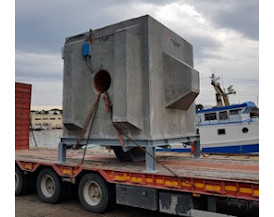Structural Health Monitoring Against Coastal Erosion
Beach-cast litter and coastal erosion – the entire Mediterranean coastline is facing two severe problems. By developing a smart recycling circuit and using the outcome to protect the coastline, the Eco-Smart Breakwater project transforms the existing problem into a new opportunity. A significant role in this development is covered by HBK: the measuring and monitoring of essential structural conditions.
The ECO-SMART BREAKWATER Project
Using litter for marine environmental protection. What sounds contradictory became a successful environmental, economic and technological approach with the ECO-SMART BREAKWATER project.
The "ecological" aspect of this project is based on a recycling process. Aggregate from construction and demolition work and fiber, obtained from the litter of oceanic Posidonia, are transmuted into elements for a breakwater system. Thus, the very same ecosystem the elements arise from also benefits from it - the marine habitat.
The "smart" part of the solution is the instrumentation with HBK optical sensors, which ensure the monitoring of marine environmental and structural parameters. These signals are acquired and processed in real time by a remote station.
Why structural health monitoring? For monitoring, controlling, and managing structural risks in real time. The information on the tensile state of the breakwater elements is of fundamental importance, as tensile stresses within these elements may - in extreme conditions - induce fracturing. The consequence could be the compromise of the stability of the entire breakwater system.
Problem
The coastline of the Apulian region faces the problem of beach-cast litter and coastal erosion.
Solution
By recycling beach-cast litter and using the resulting cubes as breakwater elements, the Apulian coastline is protected against coastal erosion. HBK optical sensors measure and monitor environmental conditions and give highly important information on the tensile state of the used elements.
Results
With this solution, the Eco-Smart Breakwater Project transforms the problem of beach cast litter into a new opportunity to protect the coastline against proceeding coastal erosion. HBK optical sensors and a structural health monitoring system are part of the solution as by their comprehensive functionality they keep the cost to a minimum.
Covering All Monitoring Needs: HBK Optical Sensors
One or more proposals for the type of sensor to be used were considered for each category of parameter monitored (mechanical, hydrodynamic and biological), to determine the solution that would cover the required range of parameters while minimizing overall costs.
The most versatile, high performance and cost-effective solution consists of HBK optical fiber Bragg grating sensors (FS series), used in conjunction with an FS22 BraggMETER interrogator as an acquisition system.
The sensors used are strain sensors (FS62), temperature sensors (FS63), and accelerometers (FS65). Optical fiber Bragg grating (FBG) sensors are chosen as they may be used to monitor both, structural (deformation and vibration) and environmental (temperature) parameters. Multiple sensors are connected to one another in a chain configuration, the chain then is connected to the optical interrogator.
Validation: Close Examination on the Sensors' Suitability
Before installing the HBK optical fiber sensors on the full-scale breakwater element, they were validated by the Resilient and Sustainable Civil Engineering Unit team of the Brindisi-based CETMA Center, in collaboration with Skema srl. To ensure that the sensors work properly, they were first tested on a prototype in small physical laboratory tests.
To show if the results of the FBG sensor are coherent with conventional sensors, a comparison was made: 1. the response of the HBK FBG sensor, embedded in a concrete cylinder to a cyclic compression test with loads between 1 and 5 MPa, with: 2. the response of conventional electric elastic extensometers, fixed with adhesive on the surface of the cylinder itself.
The comparison showed that the FBG sensor responds in a way that congruently responded to stress. A difference between the values of the two sensors was due to the different positions in which the measurement was made.

Sensor Positioning: Gathering Inside and Outside Data
The optical fiber sensors are configured and installed in two chains.
Fig.1 shows the internal chain:
To distinguish a temperature signal from a deformation signal, 4 deformation sensors and 2 temperature sensors are connected in a single chain, embedded in the concrete during fabrication of the ECOSMART – BREAKWATER element.

Fig.2 illustrates the external chain:
2 accelerometers and 1 temperature sensor are connected in a chain, anchored to the exterior of the ECOSMART – BREAKWATER element.

The system is completed by a set of devices and software which acquire the data from the sensors, store it locally and transmit it to the remote systems.
| Sensor | Type | Quantity | Position |
| Deformation | FBG | 4 | Embedded in block |
| Temperature | FBG | 2 | Embedded in block |
| Temperature | FBG | 1 | On exterior of block |
| Accelerometer | FBG | 2 | On exterior of block |
Monitoring the Breakwater Element in the Marine Environment
In the running project, after test and validation, the ECOSMART – BREAKWATER elements were transported to and installed at the breakwater of the port of Otranto. This site was chosen because the cubic and parallelepiped geometry of the artificial elements, which are used to construct the breakwater, facilitated the inclusion of the new element.
The pilot test along the breakwater gives further information on the optimum compound of the element, which is planned to be patented before being introduced to the market. Additionally, it becomes possible to verify the quality of the sensor data wireless, even in rough conditions.
About CETMA
CETMA, Technologies Design and Materials European Research Centre, founded in 1994, is a Research and Technology Organization (RTO) based in Brindisi, Italy. It carries out over than 20 years applied research, experimental development and technology transfer in the field of advanced materials (composites, polymers, bio-based and recycled), ICT (development of specialized software for engineering, manufacturing and services) and product development. It is a non-profit organization and reinvests all profits in research, training and technology transfer.



